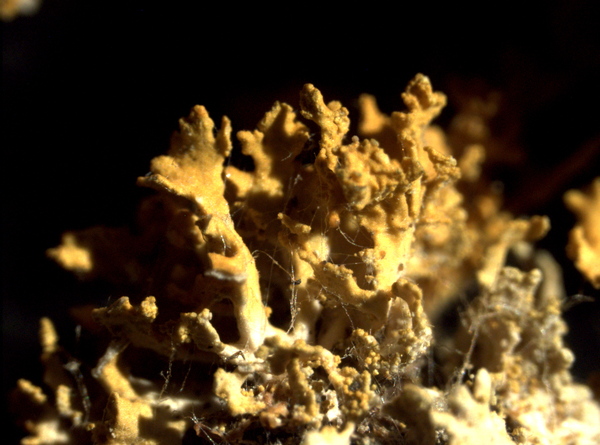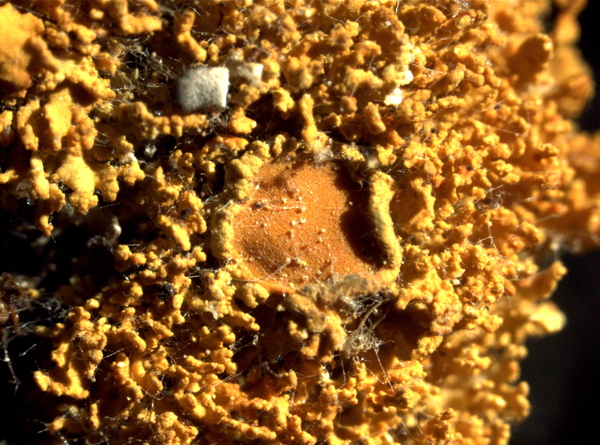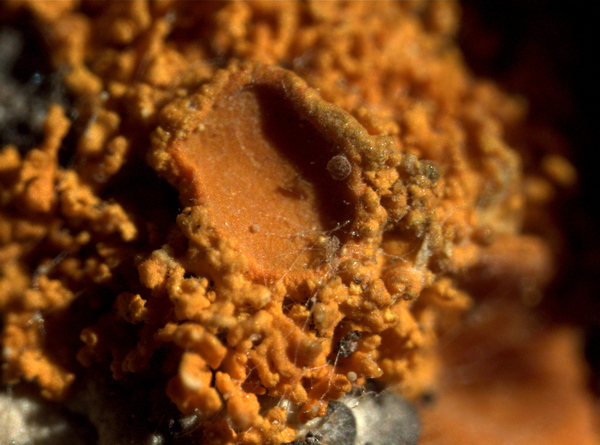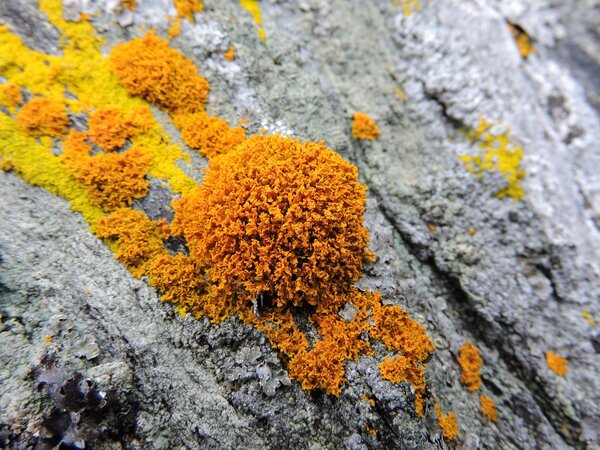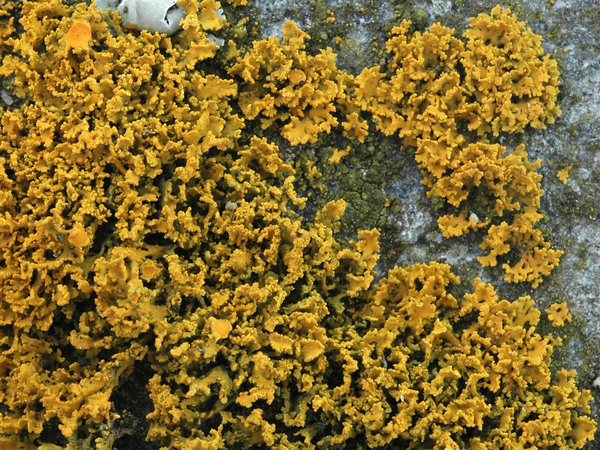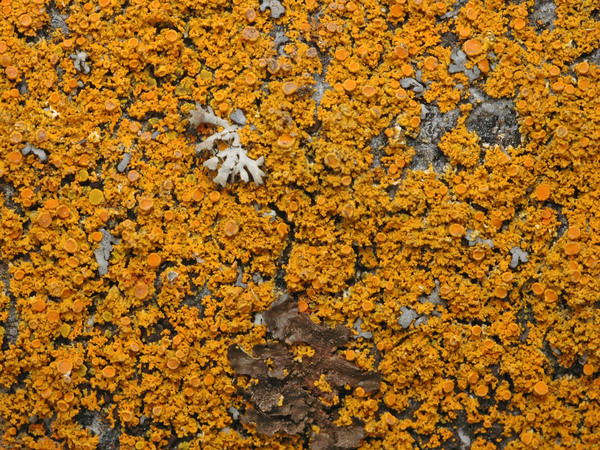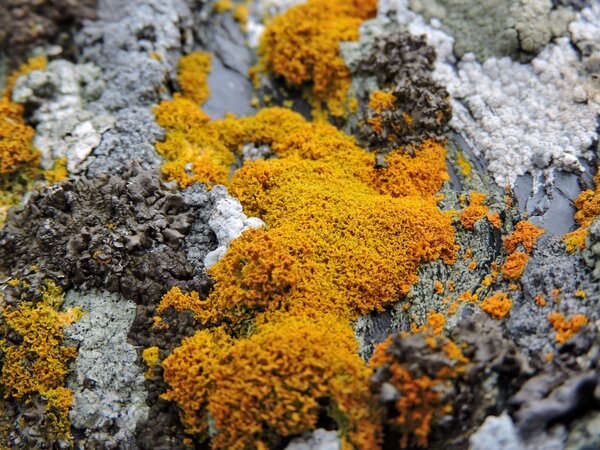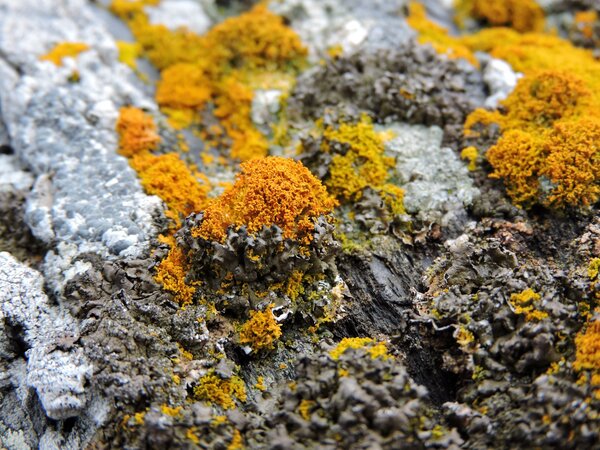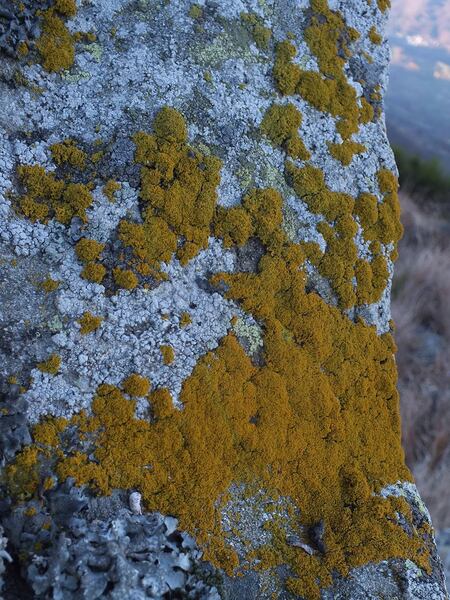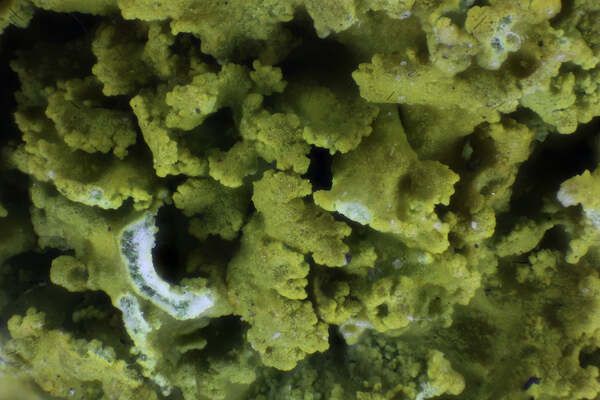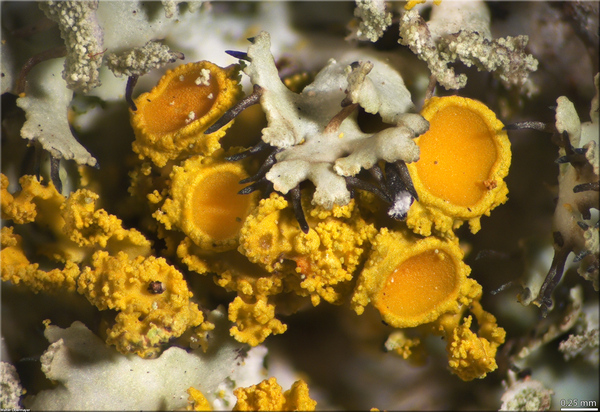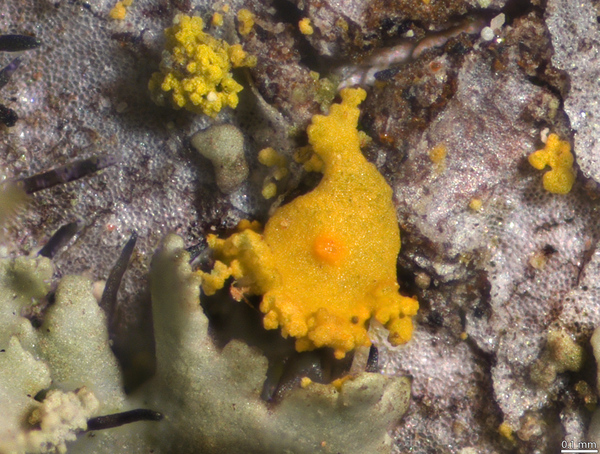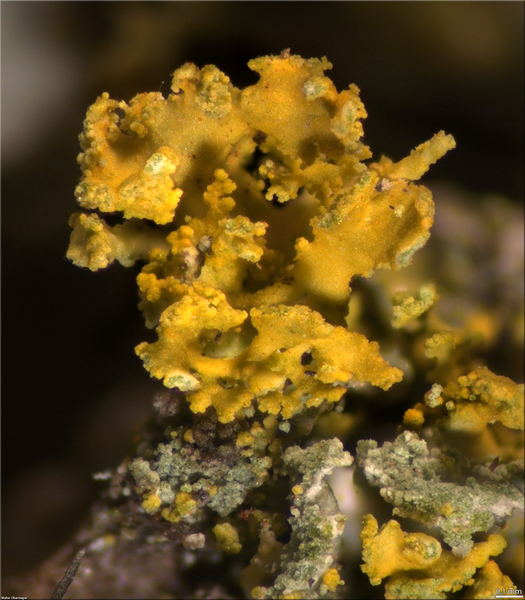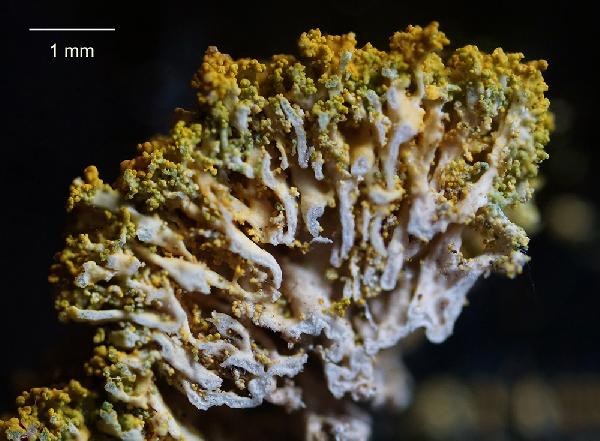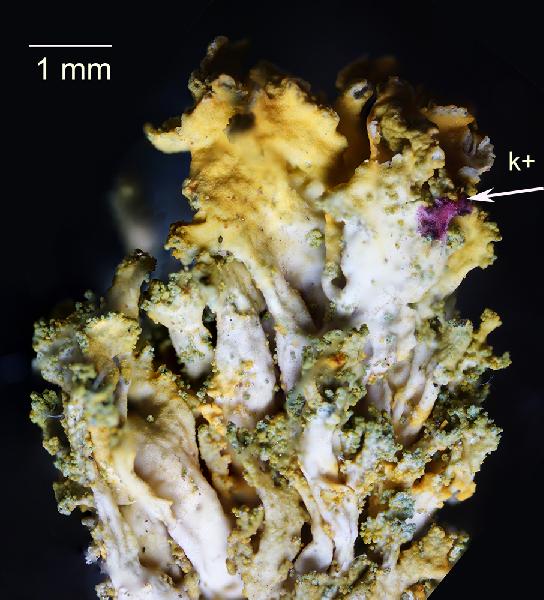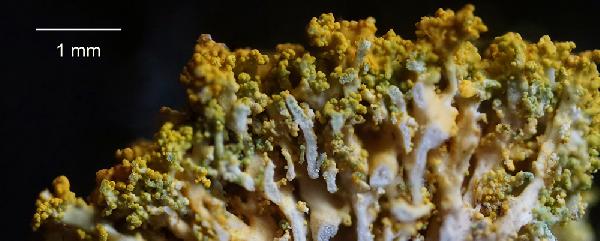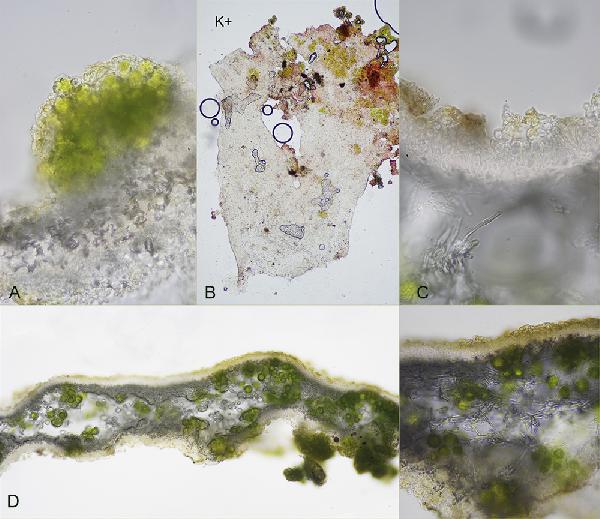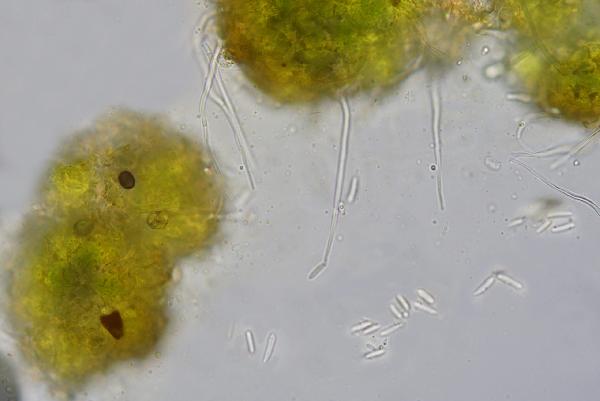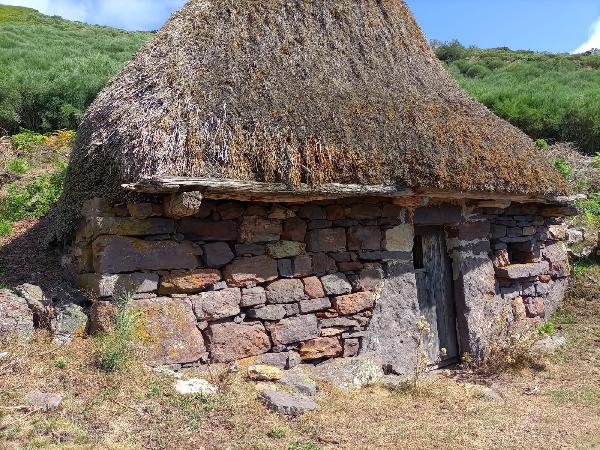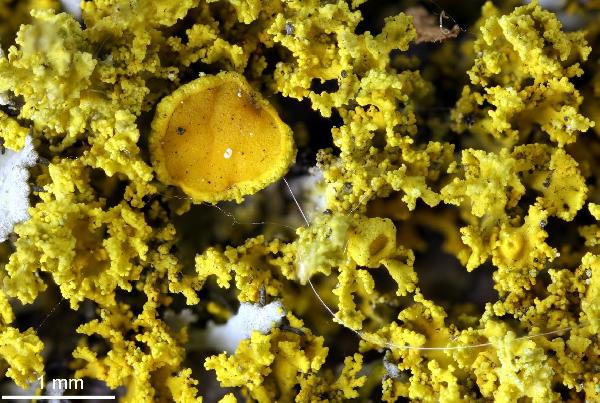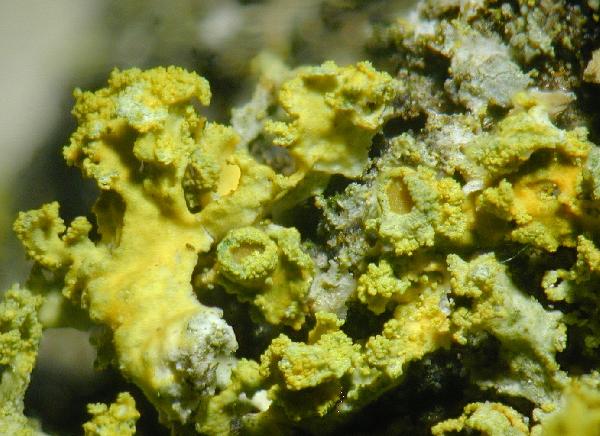Polycauliona candelaria (L.) Frödén, Arup & Søchting
in Arup & al., Nord. J. Bot, 31: 51, 2013. Basionym: Lichen candelarius L. - Sp. Pl., 1141, 1753.
Synonyms: Lecanora candelaria (L.) Ach.; Massjukiella candelaria; Parmelia parietina var. candelaria (L.) Spreng.; Physcia candelaria (F.H. Wigg.) Anzi; Physcia controversa A. Massal.; Physcia lychnea (Ach.) Nyl.; Placodium candelarium F.H. Wigg.; Xanthoria candelaria (L.) Th. Fr.; Xanthoria controversa (A. Massal.) Rabenh.; Xanthoria lychnea (Ach.) Th. Fr. non auct. p.p.; Xanthoria lychnea var. perfusa (Nyl.) H. Olivier; Xanthoria lychnea var. pygmaea (Bory) Th. Fr.
Distribution: N - Frl, Ven (Nascimbene & Caniglia 1997, 2003c, Caniglia & al. 1999, Nascimbene 2008c), TAA (Nascimbene & Caniglia 2000b, Nascimbene & al. 2005, 2006, 2008c, 2022, Nascimbene 2008b, 2014, 2014c, Zarabska & al. 2009, Nascimbene & Marini 2015, Trindade & al. 2021), Lomb (Arosio & al. 2003, Nascimbene & al. 2006e, Furlanetto 2010), Piem (Caniglia & al. 1992, Morisi & Sereno 1995, Arosio & al. 1998, Piervittori 1998, Isocrono & al. 2004, 2007, Furlanetto 2010), VA (Piervittori & Isocrono 1999, Piervittori 2003, Matteucci & al. 2008, 2008c, , Lich. Ital. Exs. 70: Isocrono & al. 2022), Emil (Fariselli & al. 2020), Lig (Brunialti & al. 1999, Giordani & al. 2002b, Brunialti & Giordani 2003). C - Tosc (Brackel 2015, Frati & Brunialti 2023), Umb (Ravera 2000, Brackel 2015), Laz (Brackel 2015), Abr (Nimis & Tretiach 1999), Sar (Zedda 2002). S - Cal (TSB 11003).
Description: Thallus foliose to subfruticose, yellow-orange to orange, forming small, up to 2(-3) cm wide cushions which often merge into extensive colonies. Lobes erect, flattened but at least partially subterete, 0.2-0.5 mm wide (the tips slightly thinner), often wrinkled, the lobe tips and the lower side with 25-35 µm wide blastidia often aggregated into (40-)45-70(-110) µm wide conblastidia. Lower surface white to yellow, somewhat wrinkled, usually without hapters and rhizines. Cortex paraplectenchymatous; medulla white. Apothecia rare, lecanorine, stipitate, subterminal, (0.5-)1-3(-4) mm across, with an orange disc and a blastidiate, finally sometimes excluded thalline margin. Thalline exciple paraplectenchymatous; epithecium orange-brown, c. 10 µm high, K+ purple-red; hymenium colourless, 60-90 µm high; paraphyses simple or sparingly branched; hypothecium colourless to pale brown, 25-70 µm high. Asci 8-spored, clavate, functionally unitunicate, apically thickened with a broad internal beak, the inner part of apex and external cap I+ blue, Teloschistes-type. Ascospores 2-celled, polarilocular, hyaline, ellipsoid, 11-15 x (4.5-)6-8(-10) µm, the equatorial thickening (“septum”) 3-6 µm. Pycnidia common, immersed, concolorous with upper surface or slightly darker orange. Conidia ellipsoid, 2.3-3 x 1-1.5 µm. Photobiont chlorococcoid. Spot tests: thallus, apothecia and blastidia K+ purple-red, C-, KC-, P-, UV+ intensely orange-red. Chemistry: parietin (major), fallacinal, emodin, teloschistin and parietinic acid, corresponding to chemosyndrome A of Søchting (1997).Note: both on bark and on rock, sometimes also on lignum, in well-lit, eutrophicated situations; certainly not common in Italy, being restricted to upland areas with a subcontinental climate (continental Alpine valleys, eastern Apennines, etc.). The old record from Campania cited by Nimis (1993: 761) could be due to confusion with other species, and is not accepted here.
Growth form: Foliose, narrow lobed
Substrata: bark and rocks
Photobiont: green algae other than Trentepohlia
Reproductive strategy: mainly asexual, by soredia, or soredia-like structures (e.g. blastidia)
Subcontinental: restricted to areas with a dry-subcontinental climate (e.g. dry Alpine valleys, parts of Mediterranean Italy)
Commonnes-rarity: (info)
Alpine belt: very rare
Subalpine belt: rather rare
Oromediterranean belt: very rare
Montane belt: rare
Submediterranean belt: extremely rare
Padanian area: extremely rare
Humid submediterranean belt: absent
Humid mediterranean belt: absent
Dry mediterranean belt: absent
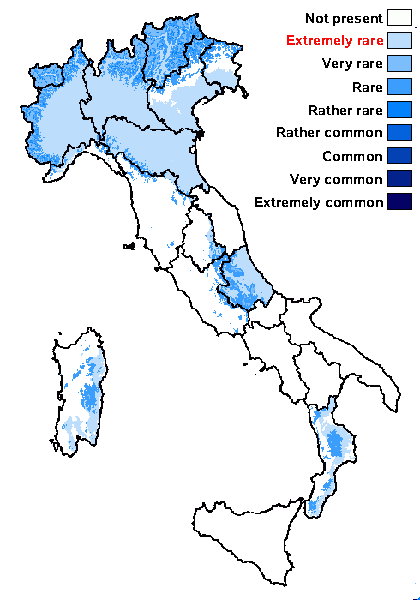
Predictive model
Herbarium samples
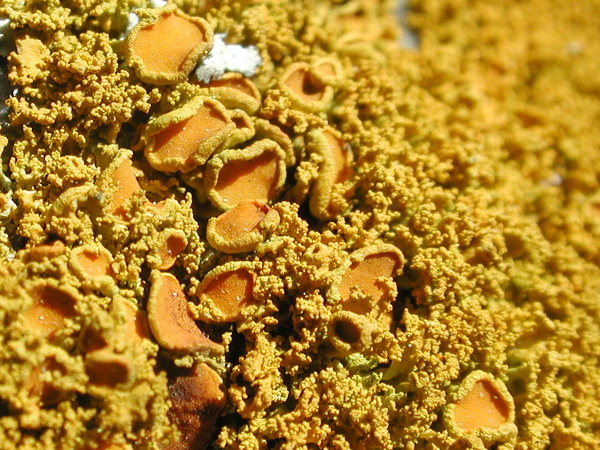
Leif Stridvall - Courtesy: Anita Stridvall - Source: http://www.stridvall.se/lichens/gallery/
holotype
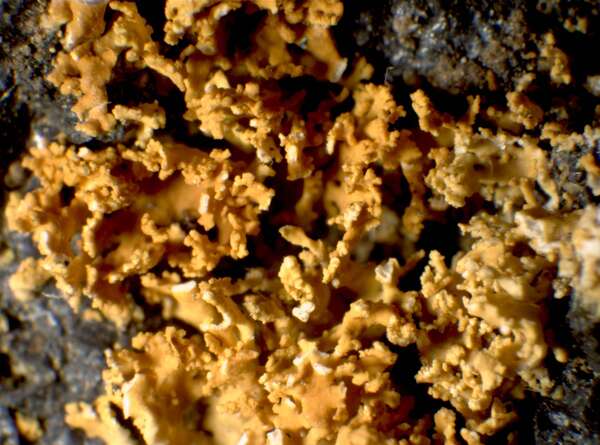

P.L. Nimis; Owner: Department of Life Sciences, University of Trieste
Herbarium: TSB (14182)
2001/12/03

Leif Stridvall - Courtesy: Anita Stridvall - Source: http://www.stridvall.se/lichens/gallery/
holotype
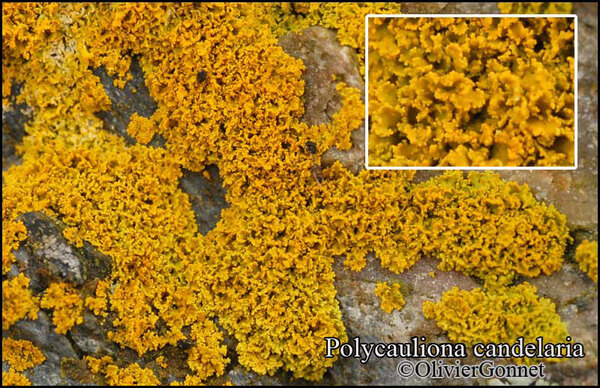
Courtesy Danièle et Olivier Gonnet - Source: https://www.afl-lichenologie.fr/Photos_AFL/Photos_AFL_P/Text_P_5/Polycauliona_candelaria.htm
France, session AFL 2005 - Finistère
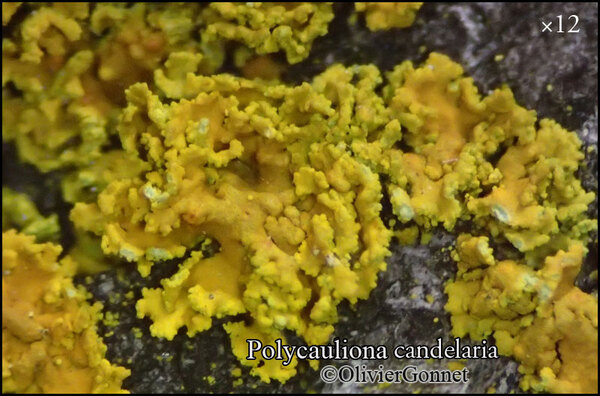
Courtesy Danièle et Olivier Gonnet - Source: https://www.afl-lichenologie.fr/Photos_AFL/Photos_AFL_P/Text_P_5/Polycauliona_candelaria.htm
France, session AFL 2014 dans le Lot
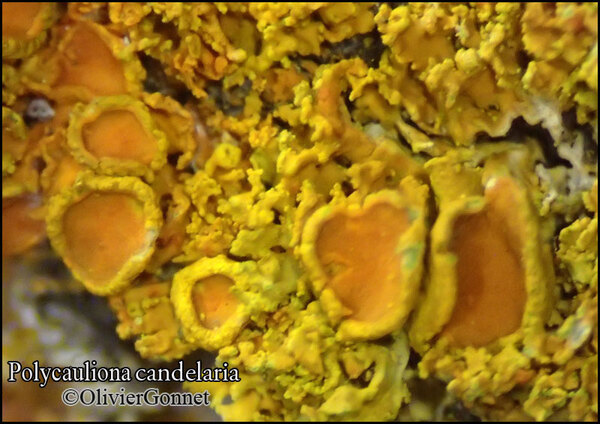
Courtesy Danièle et Olivier Gonnet - Source: https://www.afl-lichenologie.fr/Photos_AFL/Photos_AFL_P/Text_P_5/Polycauliona_candelaria.htm
France, session AFL 2014 dans le Lot

Courtesy Danièle et Olivier Gonnet - Source: https://www.afl-lichenologie.fr/Photos_AFL/Photos_AFL_P/Text_P_5/Polycauliona_candelaria.htm
France, session AFL 2014 dans le Lot
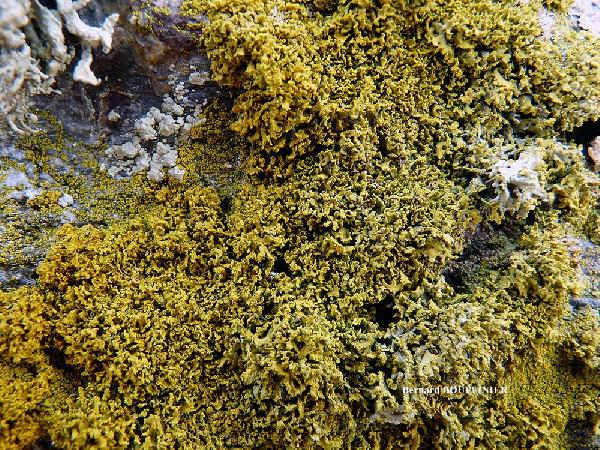
Bernard Bouffinier - Source: http://www.lichensmaritimes.org/index.php?task=fiche&lichen=767&lang=en
France, Roc'h Trédudon

Bernard Bouffinier - Source: http://www.lichensmaritimes.org/index.php?task=fiche&lichen=767&lang=en
France, Roc'h Trédudon

Michel David - Source: http://www.lichensmaritimes.org/index.php?task=fiche&lichen=767&lang=en
France, Hanvec

Bernard Bouffinier - Source: http://www.lichensmaritimes.org/index.php?task=fiche&lichen=767&lang=en
France, Gouezec
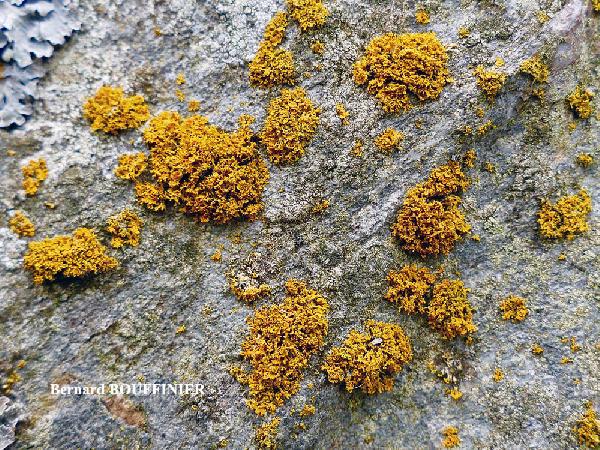
Bernard Bouffinier - Source: http://www.lichensmaritimes.org/index.php?task=fiche&lichen=767&lang=en
France, Gouezec
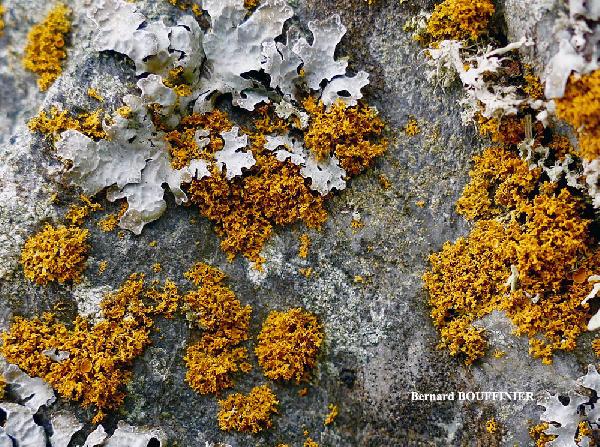
Bernard Bouffinier - Source: http://www.lichensmaritimes.org/index.php?task=fiche&lichen=767&lang=en
France, Gouezec
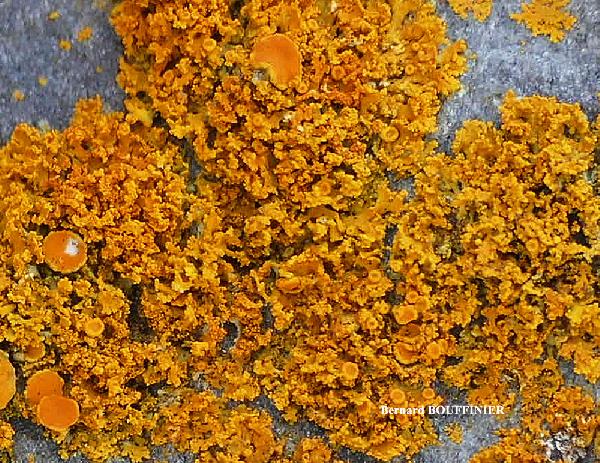
Bernard Bouffinier - Source: http://www.lichensmaritimes.org/index.php?task=fiche&lichen=767&lang=en
France, Gouezec

Bernard Bouffinier - Source: http://www.lichensmaritimes.org/index.php?task=fiche&lichen=767&lang=en
France, Roc'h Trevezel
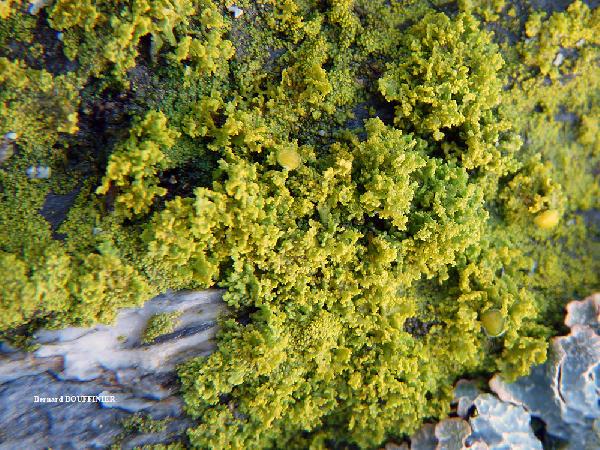
Bernard Bouffinier - Source: http://www.lichensmaritimes.org/index.php?task=fiche&lichen=767&lang=en
France, Roc'h Trevezel
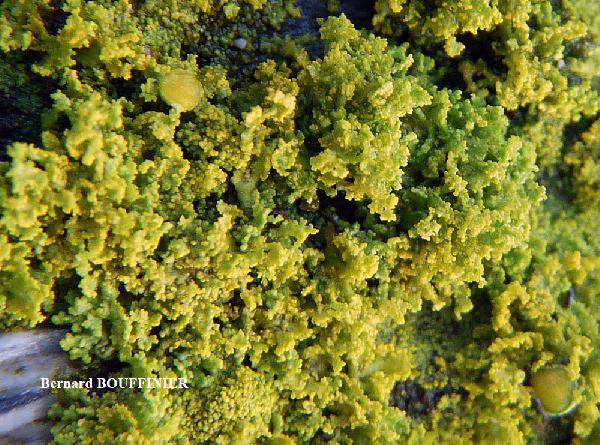
Bernard Bouffinier - Source: http://www.lichensmaritimes.org/index.php?task=fiche&lichen=767&lang=en
France, Roc'h Trevezel
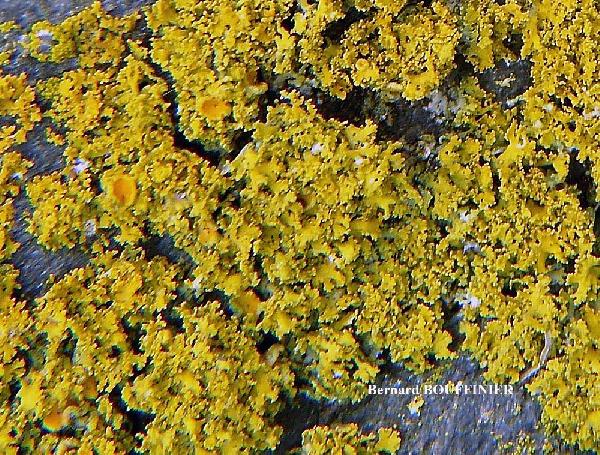
Bernard Bouffinier - Source: http://www.lichensmaritimes.org/index.php?task=fiche&lichen=767&lang=en
France, Roche du Feu
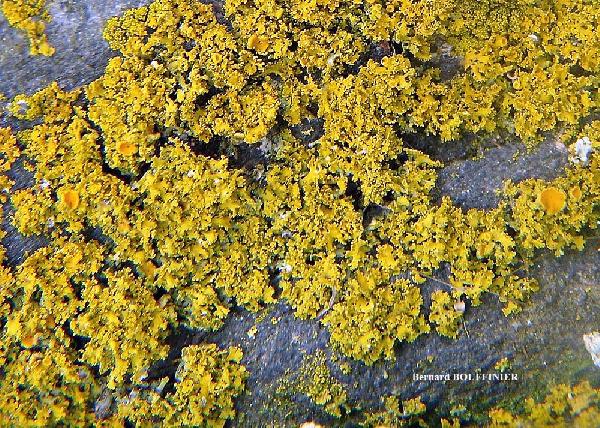
Bernard Bouffinier - Source: http://www.lichensmaritimes.org/index.php?task=fiche&lichen=767&lang=en
France, Roche du Feu
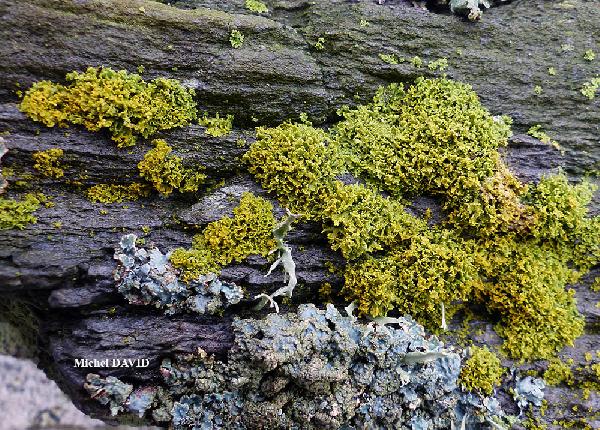
Michel David - Source: http://www.lichensmaritimes.org/index.php?task=fiche&lichen=767&lang=en
France, Hanvec
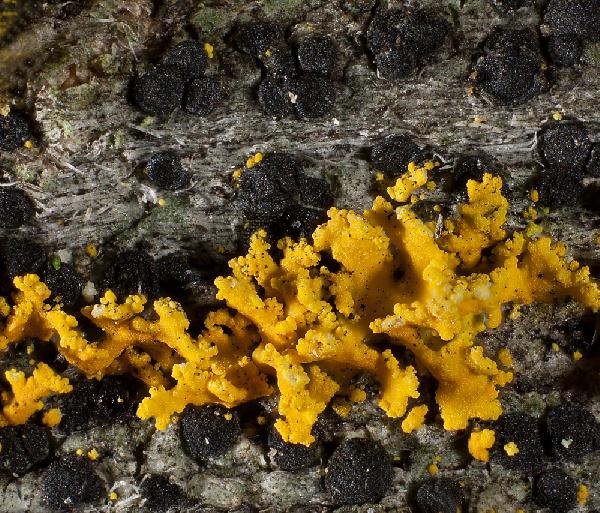
Ulrich Kirschbaum CC BY-SA 4.0 - Source: https://www.thm.de/lse/ulrich-kirschbaum/flechtenbilder
Central Europe.
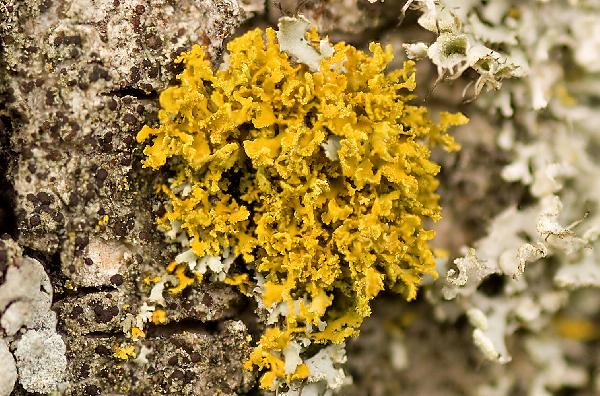
Ulrich Kirschbaum CC BY-SA 4.0 - Source: https://www.thm.de/lse/ulrich-kirschbaum/flechtenbilder
Central Europe.


Felix Schumm - CC BY-SA 4.0
[14916], Germany, Baden-Württemberg, Schwäbische Alb, Alb-Donaukreis,
nördlich von Westerheim, Straßenbäume (meist Ahorn),
48,52485° N, 9,62333° E, 830 m. Leg. F. Schumm 24.05.2009.
Growth form: Foliose, narrow lobed
Substrata: bark and rocks
Photobiont: green algae other than Trentepohlia
Reproductive strategy: mainly asexual, by soredia, or soredia-like structures (e.g. blastidia)
Subcontinental: restricted to areas with a dry-subcontinental climate (e.g. dry Alpine valleys, parts of Mediterranean Italy)
Commonnes-rarity: (info)
Alpine belt: very rare
Subalpine belt: rather rare
Oromediterranean belt: very rare
Montane belt: rare
Submediterranean belt: extremely rare
Padanian area: extremely rare
Humid submediterranean belt: absent
Humid mediterranean belt: absent
Dry mediterranean belt: absent

Predictive model
| Herbarium samples |

Leif Stridvall - Courtesy: Anita Stridvall - Source: http://www.stridvall.se/lichens/gallery/
holotype


P.L. Nimis; Owner: Department of Life Sciences, University of Trieste
Herbarium: TSB (14182)
2001/12/03

Leif Stridvall - Courtesy: Anita Stridvall - Source: http://www.stridvall.se/lichens/gallery/
holotype

Courtesy Danièle et Olivier Gonnet - Source: https://www.afl-lichenologie.fr/Photos_AFL/Photos_AFL_P/Text_P_5/Polycauliona_candelaria.htm
France, session AFL 2005 - Finistère

Courtesy Danièle et Olivier Gonnet - Source: https://www.afl-lichenologie.fr/Photos_AFL/Photos_AFL_P/Text_P_5/Polycauliona_candelaria.htm
France, session AFL 2014 dans le Lot

Courtesy Danièle et Olivier Gonnet - Source: https://www.afl-lichenologie.fr/Photos_AFL/Photos_AFL_P/Text_P_5/Polycauliona_candelaria.htm
France, session AFL 2014 dans le Lot

Courtesy Danièle et Olivier Gonnet - Source: https://www.afl-lichenologie.fr/Photos_AFL/Photos_AFL_P/Text_P_5/Polycauliona_candelaria.htm
France, session AFL 2014 dans le Lot

Bernard Bouffinier - Source: http://www.lichensmaritimes.org/index.php?task=fiche&lichen=767&lang=en
France, Roc'h Trédudon

Bernard Bouffinier - Source: http://www.lichensmaritimes.org/index.php?task=fiche&lichen=767&lang=en
France, Roc'h Trédudon

Michel David - Source: http://www.lichensmaritimes.org/index.php?task=fiche&lichen=767&lang=en
France, Hanvec

Bernard Bouffinier - Source: http://www.lichensmaritimes.org/index.php?task=fiche&lichen=767&lang=en
France, Gouezec

Bernard Bouffinier - Source: http://www.lichensmaritimes.org/index.php?task=fiche&lichen=767&lang=en
France, Gouezec

Bernard Bouffinier - Source: http://www.lichensmaritimes.org/index.php?task=fiche&lichen=767&lang=en
France, Gouezec

Bernard Bouffinier - Source: http://www.lichensmaritimes.org/index.php?task=fiche&lichen=767&lang=en
France, Gouezec

Bernard Bouffinier - Source: http://www.lichensmaritimes.org/index.php?task=fiche&lichen=767&lang=en
France, Roc'h Trevezel

Bernard Bouffinier - Source: http://www.lichensmaritimes.org/index.php?task=fiche&lichen=767&lang=en
France, Roc'h Trevezel

Bernard Bouffinier - Source: http://www.lichensmaritimes.org/index.php?task=fiche&lichen=767&lang=en
France, Roc'h Trevezel

Bernard Bouffinier - Source: http://www.lichensmaritimes.org/index.php?task=fiche&lichen=767&lang=en
France, Roche du Feu

Bernard Bouffinier - Source: http://www.lichensmaritimes.org/index.php?task=fiche&lichen=767&lang=en
France, Roche du Feu

Michel David - Source: http://www.lichensmaritimes.org/index.php?task=fiche&lichen=767&lang=en
France, Hanvec

Ulrich Kirschbaum CC BY-SA 4.0 - Source: https://www.thm.de/lse/ulrich-kirschbaum/flechtenbilder
Central Europe.

Ulrich Kirschbaum CC BY-SA 4.0 - Source: https://www.thm.de/lse/ulrich-kirschbaum/flechtenbilder
Central Europe.


 INDEX FUNGORUM
INDEX FUNGORUM
 GBIF
GBIF
 DOLICHENS
DOLICHENS
